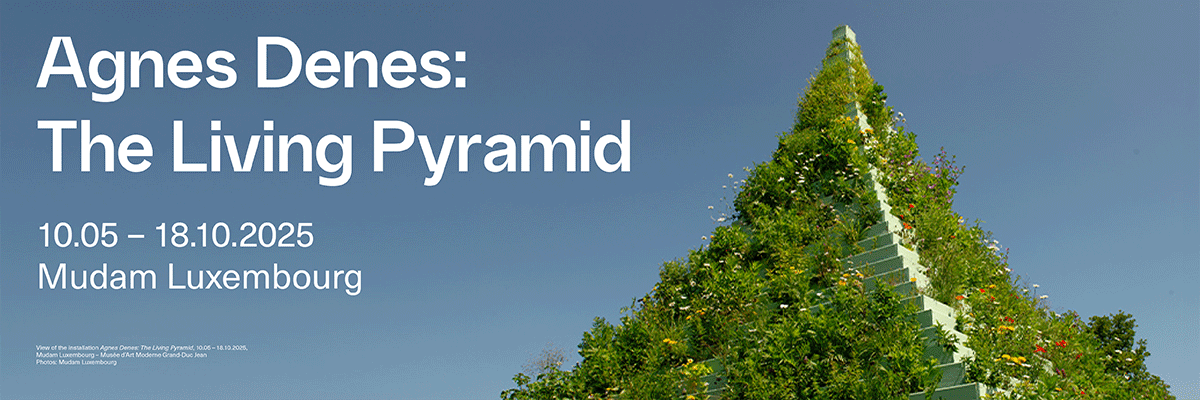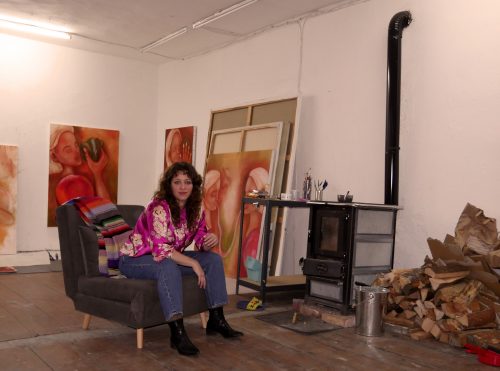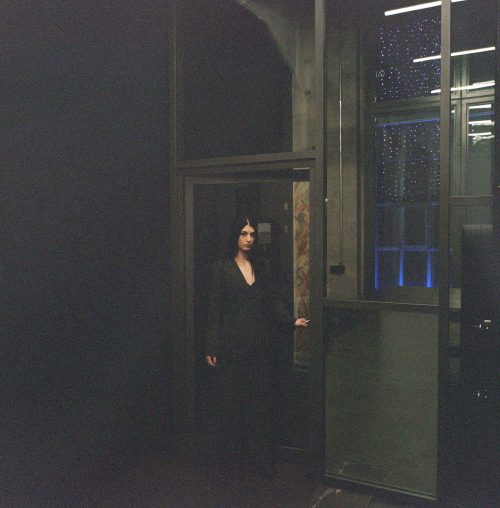
André Butzer
Maikäfer flieg!
Project Info
- 💙 Kunstverein Friedrichshafen
- 💚 Hannah Eckstein
- 🖤 André Butzer
- 💜 Hannah Eckstein
- 💛 Kilian Blees
Share on

»Maikäfer flieg! (2)«, 2022, Acrylic on Canvas, 296 × 190 cm / 116.5 × 74.8 in.; »Maikäfer flieg! (3)«, 2022, Acrylic on Canvas, 298 × 191 cm / 117.3 × 75.2 in.
Advertisement

»Maikäfer flieg! (2)«, 2022, Acrylic on Canvas, 296 × 190 cm / 116.5 × 74.8 in.; »Maikäfer flieg! (3)«, 2022, Acrylic on Canvas, 298 × 191 cm / 117.3 × 75.2 in.

»Maikäfer flieg! (3)«, 2022, Acrylic on Canvas, 298 × 191 cm / 117.3 × 75.2 in.

»Maikäfer flieg! (2)«, 2022, Acrylic on Canvas, 296 × 190 cm / 116.5 × 74.8 in.

»Maikäfer flieg! (1)«, 2022, Acrylic on Canvas, 293 × 189 cm / 115.3 × 74.4 in.

»Untitled (Warnemünde)«, 2022; »Untitled (der Birnbaum in Warnemünde)«, 2022; »Untitled (Hohen-Lohe)«, 2022; »da IST ER … (die Donau)«, 2022; »Maikäfer flieg! (2)«, 2022

»Untitled (Warnemünde)«, 2022; »Untitled (der Birnbaum in Warnemünde)«, 2022; »Untitled (Hohen-Lohe)«, 2022; »da IST ER … (die Donau)«, 2022

»Untitled (Warnemünde)«, 2022, Watercolour and Pencil on Paper, 36 × 48 cm / 14.1 × 18.8 in.; »Untitled (der Birnbaum in Warnemünde)«, 2022, Watercolour and Pencil on Paper, 36 × 20 cm / 14.1 × 7.8 in.

»Untitled (Hohen-Lohe)«, 2022, Watercolour and Pencil on Paper, 36 × 48 cm / 14.1 × 18.8 in.; »da IST ER … (die Donau)«, 2022, Watercolour and Pencil on Paper, 36 × 20 cm / 14.1 × 7.8 in.

»Maikäfer flieg! (1)«, 2022; »Untitled (Warnemünde)«, 2022; »Untitled (der Birnbaum in Warnemünde)«, 2022; »Untitled (Hohen-Lohe)«, 2022; »da IST ER … (die Donau)«, 2022

»Maikäfer flieg! (1)«, »Untitled (Warnemünde)«, »Untitled (der Birnbaum in Warnemünde)«, »Untitled (Hohen-Lohe)«, »da IST ER … (die Donau)«, »Maikäfer flieg! (2)«

»Am grünen Abhang...«, 2023, Poem

»Am grünen Abhang...«, 2023, Poem; »Untitled (Nasaheim)«, 2023, Acrylic on Canvas, 32 × 61 cm / 12.6 × 24 in.

»Untitled (Nasaheim)«, 2023, Acrylic on Canvas, 32 × 61 cm / 12.6 × 24 in.

»Untitled (Engele flieg!)«, 2023, Pencil on Paper, 9,8 × 21 cm / 3,7 × 6,3 in.
Maybug fly!
It’s almost impossible for an antinomy to be put more innocently into words than in the lyrics and melody of the »Maybug song«. While it shares its peaceful and consoling melody with the lullaby »Sleep, dear child, sleep, the lyrics speak of war and the loss of the parents. It is ambiguous and puzzling. Uncertainty prevails, if the parents perished in the war or if there is hope for a reunion still.
The three terrifying lines »Your father is at war / Mother’s in Pomerania / Pomerania’s been scorched« are framed by »Maybug, fly!«. Maybe a sign that, in the end, hope, not terror, persists. After all, the maybug is a herald of spring and a symbol of cyclical renewal.
Its meaning is nonetheless hazy. The poets’ association »Maikäferbund,« banned in 1848, chose its name for the very reason that, until then, the maybug was considered a pest and fought against. And the first cruise missile employed by Nazi Germany, the »Vengeance Weapon 1,« was colloquially called »maybug«, too, due to its characteristic buzz-tone.
The folk and children’s song can be traced back to around 1800. Although it probably originated during the Thirty Years’ War. Ever since, it has deeply inscribed itself into the collective German memory. All too much, the lyrics reflected the reality of many.
Particularly, displacement and expulsion after the Second World War fostered its sad popularity. In 1963, Paul Celan read »tiny sheaves of hope« from the fateful lines. In 1974, Anselm Kiefer associated it to Adolf Hitler’s »Nero Decree«, intended to destroy the Reich’s complete infrastructure by means of »scorched earth tactics.«
In 2023, André Butzer calls his exhibition in Friedrichshafen »Maikäfer flieg!« For the Kunstverein, he has created four watercolors along three monumental paintings. The latter are serial paintings of one of his iconic characters: the »Man of Shame.« That’s no coincidence. For, just like the song, Butzer’s entire œuvre is marked by contradictions and oppositions.
Its foundation being not only the upheavals in painting but all the horrors and promises, the industrial revolution and modernity have spawned. Including the National Socialists’ mass extermination as well as the premises of capitalist mass consumption, Friedrich Hölderlin as well as Henry Ford, Walt Disney or Coca-Cola.
Painting in the 19th century clings to a petrified tradition, unwilling to acknowledge its crisis-like failure as a meaningful institution, which leads to a grave alienation of image, man and world. At the same time, a handful of artists recognize this disunion and embark on a search for new historical purpose and communion—for the image and their own existence.
Amidst this epochal rupture lived all those personalities, who for Butzer hold the position of »patron saints«1, as they »help him do his thing«2. Next to Hölderlin, Ford and Disney, these are Paul Cézanne, Henri Matisse, Piet Mondrian and Edvard Munch. It comes as no surprise that all of them realize the fractured time at the turn of the 19th to the 20th century in their work and try to painterly reunite these opposites.
Their inner turmoil, fuelled by personal misfortune or the profound detriments the new world and the loss of history in painting entailed, is another shared feature. The incomprehension and rejection they and their works faced throughout their lives, made them restless seekers of a place in the world for themselves and their art.
André Butzer still feels the disintegration of image, man and world at the end of the 20th century. In turn, from on 1999 he has developed »Science Fiction Expressionism« and his personal pictorial universe. His own image becomes his homestead, thus harboring the very possibility to painterly endure and withstand all contradictions that made him a restless seeker as well, a wanderer.
Butzer’s seemingly cartoon-like figures manifest the fundamental conflict of human existence—the inseparability of good and evil. Past, present and future merge and give rise to a fictitious pictorial world, albeit one imbued with the real and his sensibility. In this world, everything beautiful and horrific, bliss and misfortune, all love and all hate, joy and sorrow are inseparably equal parts of human existence.
The Man of Shame is Butzer’s first valid character. Embodying all that is vile in the world—the inherent contradictoriness of human existence as well as the inner strife, modernity has left behind. He bears the guilt of National Socialism as much as the repercussions of boundless, global capitalism. As an offspring of mass media and the entertainment industry, the Man of Shame holds within himself all the abysses of earthly existence.
In search of peace and a place in the world, he becomes a wanderer. Hölderlin and Cézanne, Matisse and Munch, all were seekers. Wanderers in their times, who only with utmost toil succeeded in »taking an individual and exemplary stance, in holding their ground artistically«3. It is here, where the pictorial figure and Butzer’s biography coincide. He, too, is a homeless wanderer who paints himself throughout history into a vague future.
In the three paintings of the exhibition, the Man of Shame initially seems to be, as in the Maybug song, an innocent, almost exhilarating apparition. At second glance, though, this impression reverses itself. The wide-open eyes merely are huge pupils, staring out of the paintings with a piercing gaze. The open mouths are contorted into a scornful grimace and the heads resemble skulls or the insignia of the SS.
In »Maikäfer flieg! (1)«, the Man of Shame floats around like a helpless insect floundering on its back. Or is he in free fall, having already lost his walking cane in fright? The short brown block in »Maikäfer flieg! (2)« reaffirms this impression, pushing vehemently onto the plane from the right and stopping abruptly at the Man of Shame’s leg—as if he was thrown into the image. Only in »Maikäfer flieg!« (3) does he finally gain a brief abode upon the solid brown beam. Sitting, standing, flying or falling … a precarious existence.
The painting’s yellow, ochre and brown fields are just as hard to determine. They might be wheat fields, rays of sunlight or blazing flames, »scorched earth« so to say. »Gruß aus Pomm-Pomm«, painted in 2003, hints at this. The occasion was a train trip to Poland, which Butzer undertook in the spring of 2003 with his then future wife Maja Körner to the seaside town of Kołobrzeg in West Pomerania. An incisive journey.
On the way, they passed through fields, being cleared by fire and prepared for sowing. The flames scorched high as the train windows, unfolding an inferno of acute and historical associations before Butzer’s eyes. After his return, he creates »Gruß aus Pomm-Pomm«—a Man of Shame afflicted by the very same flames that had beset himself.
Butzer musters such experiences in his »Maikäfer flieg!» exhibition. »Untitled (Hohen-Lohe)« reiterates the idea of flames. »Lohe« means as much as a large or high fire, the adjective »loh« flaming. On the plane, the freely dispersed patches and bands of color allude to a burning landscape just as the watercolor’s chromaticity, primarily red, orange and brown hues, comes very close to a blazing fire.
Butzer’s Maybug paintings grew from his contemplation of Edvard Munch’s time in Warnemünde. In the midst of a personal crisis, consisting of blows of fate, alcoholism, nervousness and a shaken psyche, Munch settled in the calm Baltic seaside town in 1907. »Far from the big cities with their gossip and scandals, away from any high-flying artist crowd,« he wanted to find his way back to a »grounded, simple life«4.
A short but prolific period of life, into which an autobiographical record provides insight: »My condition worsened and worsened. I sought healing in sanatoriums in Kösen and Elgersburg to no avail as well as in the seaside resort of Warnemünde, where I painted bathing men. After a severe breakdown in 1907–1908, I had to go to Jacobson’s clinic in Copenhagen eventually. Back then, my sole consolation was the feeling that my capability wasn’t hampered.«5
In the paintings of the aforementioned »bathing men«, Munch built the plane from almost abstract, parallel bands of color, agitated by vivid brush strokes. We find similar brush work in Butzer’s Maybug paintings, which are also composed of various, parallel bands of color. The affinity is even greater in »Untitled (Warnemünde)«, in which the pictorial field—like Munch’s beach in 1907—consists of broad watercolored lanes.
We even come across the pear tree from the garden of Munch’s Warnemünde lodgings at Strom 53. In »Untitled (der Birnbaum in Warnemünde)«, it materializes from loosely placed brushstrokes that form open areas in some places. It almost dissolves into mere color, were it not held by ornamental black lines.
In a world once again out of joint, André Butzer reveals such manifold relations and references. His paintings and watercolors are as touching as they are disturbing. They call for caution and vigilance. All too easily, as history tells, man tends to repeat his transgressions and, all of a sudden, appears with a monstrously transformed face, as if in a Kafkaesque nightmare.
Whereas the figure of the Woman preserves hope, which endures in spite of everything. Her head bowed and with a benevolent gaze—like in an icon of the Virgin Mary—she looks at us, for instance in »Untitled (Frau am Birnbaum 4)«. Being the counterpart of the Man of Shame, she embodies the vital force to overcome the disunion between good and evil, creation and destruction, life and death. For it is she, who brings color and thus hope into this world.
1 André Butzer zitiert nach: Christian Malycha, Sein und Bild. André Butzer 1994–2014, Kerber, Bielefeld 2017, S. 111
2 ebenda
3 ebenda, S. 43
4 Bernd Erhard Fischer, Edvard Munch in Warnemünde, Edition A·B·Fischer, Berlin 2011, S. 11
5 Edvard Munch zitiert ebenda, S. 20
André Butzer
1973 born in Stuttgart, lives in Berlin-Wannsee
Instituional Solo Exhibitions: Museo Thyssen-Bornemisza, Madrid, and Kunstverein Friedrichshafen (2023); Friedrichs Foundation, Weidingen (2022); YUZ Museum, Shanghai, and Museum of the Light, Hokuto (2020); IKOB Musée d’Art Contemporain, Eupen (2018); Växjö Konsthall, Växjö (2017); Bayerisches Armeemuseum, Ingolstadt, and Neue Galerie Gladbeck (2016); Kunstverein Reutlingen (2015); Künstlerhaus – Halle für Kunst und Medien, Graz (2014); Kestnergesellschaft, Hanover, and Kunsthistorisches Museum / Theseustempel, Vienna (2011); Kunsthalle Nuremberg (2009); Kunstverein Ulm (2005); Kunstverein Heilbronn (2004)
Selected Public Collections: Art Institute of Chicago; Carré d’Art – Musée d’Art Contemporain, Nîmes; Children’s Museum of the Arts, New York; Contemporary Art Collection of the Federal Republic of Germany, Bonn; Deichtorhallen Hamburg; Friedrichs Foundation, Weidingen / Bonn; Hall Art Foundation, Reading / Derneburg; IKOB Musée d’Art Contemporain, Eupen; Kupferstichkabinett, State Museums, Berlin; LACMA, Los Angeles; Marciano Collection, Los Angeles; MOCA, Los Angeles; Museo Thyssen-Bornemisza, Madrid; National Gallery / Hamburger Bahnhof – Museum für Gegenwart, Berlin; Paula Modersohn-Becker Museum, Bremen; Pinakothek der Moderne, Munich; Rubell Museum, Miami; YUZ Museum, Shanghai
Hannah Eckstein




